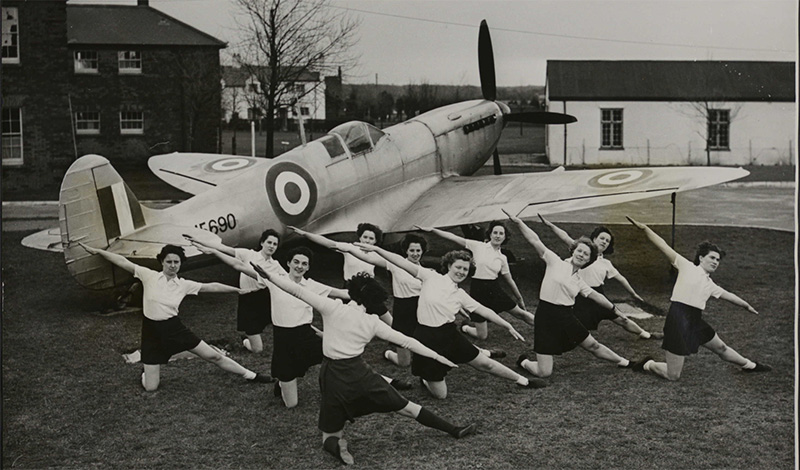Women’s Auxiliary Air Force in WW2
On June 28, in 1939, the Women’s Auxiliary Air Force (WAAF) was formed aiding the war effort and helping change the social status of women, and also the attitudes towards them.

The outbreak of World War II brought with it national conscription and subsequently a nationwide labour shortage – it was down to the women of the Britain to step up. World War II gave women the chance to break free from tradition and their usual domestic roles. And all of a sudden, almost over night, they were given the chance to prove that they could do the jobs that had long been reserved for men. At first there was a general reluctance to allow women into these new fields of employment, but as the war proceeded it became evident that, if men were to be released for combatant duty and if Britain was to be efficient and make the most of its resources, women would have to take over men’s jobs. By the end of 1941, women aged 18 – 60 were conscripted into the war effort and had to choose between war work, factory work, nursing, or join the WAAF or its army or air force equivalents, the ATS and the WRNS.
Women joined the WAAF from both the UK and overseas. The WAAF came under the administration of the RAF and members did not serve in individual female units, as with its army equivalent the ATS, but as individual members of RAF Commands. Katherine Trefusis-Forbes was the director of the WAAF and had served in the Women’s Volunteer Reserve in the First World War. Members of the WAAF were initially recruited as clerks, kitchen orderlies and drivers but as the war progressed the roles available for women continued to get more and more varied and went on to include telegraphy, telephony, and the interception of codes and ciphers, and the interpretation of aerial photographs. Women eventually then went on to take on what were considered more ‘masculine roles’ assembling weapons, building ships and aircraft, becoming mechanics, engineers, electricians and fitters for aeroplanes. That doesn’t sound so peculiar to us in the modern day – but during the thirties this would have been ground-breaking. Women were still expected to stay at home taking care of domestic duties, despite winning voting rights in 1928. Women who did work during that time were mostly either single, deserted, or economically disadvantaged – if a married woman did work it was seen as a negative reflection of the husband’s inability to support her.
A New Breed of Woman
The trouser-ed, dungaree-ed, sea-booted women of the WAAF was a new breed of female – strong and independent. The emergence of the WAAAFs helped change the initial resistance to working women and members proved that they could complete even the hardest of jobs including the operation of balloon sites – the balloons were designed to deter enemy bombers. This involved lifting and lowering the barrage balloons, which were 66 feet long and 30 feet high when inflated and there were a lot of doubts over whether women would have the physical strength or stamina to do it. But, they were successful and so successful in fact that women eventually ran more than 1,000 barrage balloon sites throughout Britain. Some members of the WAAF with particular skills were even trained as agents to be sent to occupied Europe, transferred into the Special Operations Executive (SOE). Unfortunately, one job that the women of the WAAF were not allowed to do was fly. However, the necessity of training more pilots in secondary roles to release front line pilots for active service led to the formation of the Air Transport Auxiliary (ATA). Over the course of the war, 150 women flew with the ATA, and duties included delivering new planes from factories to RAF units and shuttling planes back for repairs. All ATA pilots were civilians, as the RAF thought it unacceptable to have women pilots flying military aircraft. Members of the WAAF served all over the UK, in the US, in Egypt and later in Europe after the invasion of June 1944. The WAAF was re-formed into the WRAF in 1949, and fully integrated into the RAF in 1994. During the war opportunities opened up and the working lives of women drastically changed, their skills were sharpened and their confidence grew and their contribution to the war effort was a huge one. They also changed a lot of attitudes along the way. For example, a Group Captain in the RAF had previously been skeptical about the WAAF commenting in 1939:
“I sincerely believed that war was not a job for a woman. In war, women could tackle the more quiet and comfortable civilian jobs, and leave it to the fathers and brothers and cousins to fill the fighting services. Then at the beginning of the war came the news that we of the Royal Air Force were to have women – women in our operations rooms, women driving our transport and operating our teleprinters, women in our offices and manning our signals, even invading our messes. Petticoats in the RAF.”
After the war he had changed his opinion and stated:
“I have cause to thank goodness that this country can produce such a race of women as the WAAF of my station.”
What would you have hoped you were a part of as a woman during the Second World War – war work? the WAAF? the ATS? or WRNS? Were any of your family in the WAAF? What stories did they have to share? Let us know – we are always interested to hear your stories.
Source: BBC History and ‘The WAAF in Action’ by Adam and Charles Black, from the Forces War Records Library.

